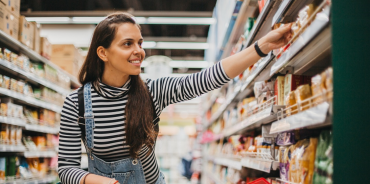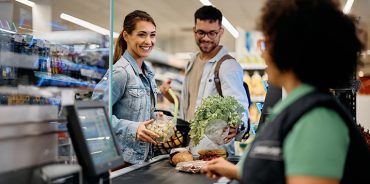How retail media helps CPGs tackle the impact of inflation
For shoppers, perception is reality. Of the many lessons that we’ve learned from our consumer facing studies over the past few years, it’s that customers often shape their behaviours in response to what they feel is happening rather than what necessarily is. For retailers and consumer-packaged goods (CPG) brands alike, that should provide food for thought in the inflationary context of our current reality.
In our most recent piece of research, published just last month, we found that inflation and the rising cost of living are significant and almost universal concerns for shoppers around the world. Of the 18,000+ consumers that we surveyed, 93% said that they’ve seen the cost of their grocery shopping rise over the past 12 months. Correspondingly, 57% believe that their personal finances are now in what they describe as a “weak” state.
While there’s a clear difference between the perceived rate of inflation on food (27%) and the actual global average (14%), that’s arguably less important than the response that it has provoked from customers. Conscious that their grocery budget is no longer going as far as it used to, many have begun to adopt aggressive cost-reduction measures that prioritise short-term savings over mid-term value.
A number of these behaviours have the potential to be actively damaging to brands. For instance:
- In spite of the better value that they typically offer, customers are trending away from larger pack sizes (down to 26% from 29% one year ago);
- They are increasingly waiting until products go on sale so that they can stock up on items in bulk (up to 39% from 36% in 2021), and;
- A growing number of customers are switching from national brand products to private label items when available (up to 34% from 30% last year).
The last of these actions in particular mirrors one of the key findings in two of our most recent Retailer Preference Index (RPI) studies. In both Spain and Italy, shoppers say that private label is now one of the most important issues to them when shopping for groceries. Specifically, shoppers are keen to have the option to “trade down” to lower-cost private label alternatives whenever they feel it makes financial sense to do so.
On the back of these behavioural shifts, CPGs will naturally be keen to ensure that they can protect their position in customer baskets – and that’s something that retail media can help with. With the right strategy behind them, CPGs can use retail media both as a defensive measure and a strategic enabler in the fight against the impact of inflation.
Let’s look at some of the ways in which that can play out.
- Retail media provides a way to defend against downtrading
Retail media and data science in combination are very powerful tools. Not only does it become possible to reach customers across their grocery retail journey, it also provides brands with the opportunity to understand the likely future behaviours of different shoppers and audience segments.
Say that a group of customers started to demonstrate similar behaviours to earlier brand lapsers, for instance. Rather than just hoping that they stay loyal, retail media provides the opportunity to engage those shoppers with a promotion or offer – maximising the likelihood that they’ll remain a customer. Retail media offers an effective way to help CPGs reduce the risk of losing loyal shoppers in a tougher economy.
- Retail media can help you outperform the competition
During the early days of the pandemic, retail media proved to be an invaluable way to highlight alternative products when a shopper's primary choice was unavailable. As global supply chains have normalised, the need to use retail media in that way has dwindled – but the principle remains intact.
In much the same way that retail media can be used to communicate potential substitutions, it also provides brands with a great way to grab the attention of customers who currently shop competing national or private brand products. Advanced audience targeting allows brands to reach out directly to shoppers who currently buy rival products – something that can be particularly effective when combined with a timely and relevant offer.
- Retail media helps brands capitalise on the "cook at home" opportunity
As well as the changing attitudes towards grocery shopping outlined above, we’ve also seen a major reduction in the number of people “eating at or from restaurants” in the past year. With their spending power reduced, many shoppers are beginning to cut back on non-essential activities, which suggests that we’re likely to see a return to the cooking from scratch trend that took hold during the height of Covid.
Just as it was during the pandemic, this presents an excellent chance for brands to use retail media and position their products effectively when customers are looking for inspiration and excitement in their shop.
- Retail media also offers a way to capitalise on the rise of "treating"
Even in these tougher times – and perhaps because of them – our research also shows that significant numbers of shoppers are keen to treat themselves and their families with a little luxury in their grocery shop. Their wallets may be under greater strain, but shoppers still want to reward themselves when they feel they can.
For CPG brands, especially those with a focus on moments and premium experiences, those behaviours will become increasingly important. Retail media – particularly targeted initiatives like product recommendations and basket additions – give advertisers a great way to tap into this trend.
From an overall communications perspective, broader activities like brand partnerships and competitions can also help to ensure that your goods remain front of mind when customers are pondering which products to buy as a treat.
Rapid changes in consumer behaviour like the ones we are currently seeing present a tough challenge for brands. Those that focus on truly understanding and engaging their customers, however, will have a much better chance of protecting both their relationships and sales as events continue to unfold.
TOPICS
RELATED PRODUCTS
Helping brands get the most from retail media
Audience Targeting solutionsUnderstand changing Shopper behaviours through unique Data Science
Shopper insights solutionsThe latest insights from our experts around the world



